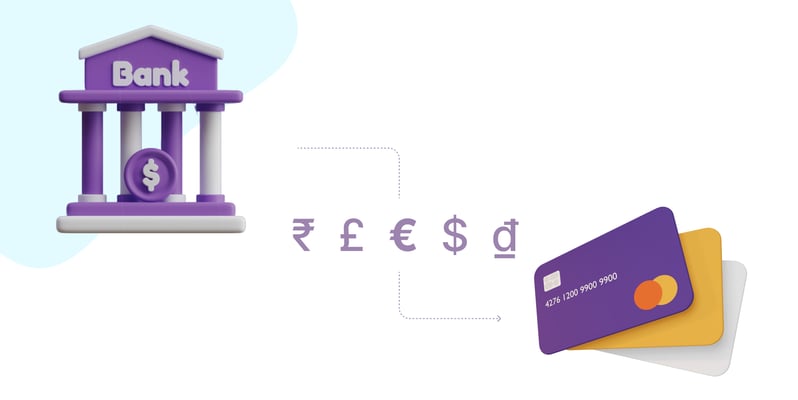Enabling cross-border payments is essential for almost all online businesses regardless of the domain. This allows you to meet the needs of a broader range of customers and sell your products/services globally. However, enabling cross-border payments comes with numerous challenges.
For instance, merchants must go through regulatory and compliance issues, high transaction fees, payment delays, etc. Fortunately, you can deal with challenges and enjoy the benefits of cross-border payments.
Below, we'll discuss what cross-border payments are, their common types, the challenges this payment brings, and how businesses can effectively deal with them. So, read in full.
What Are Cross Border Payments?
Cross-border transactions, aka international transactions, are the ones wherein the parties (sender and receiver) belong to two countries. A typical example of a cross-border transaction is a buyer from India purchasing goods from a business in the USA.
However, these transactions aren't limited to eCommerce and could include acquisitions, mergers, distribution contracts, and more.
Here are some common types of cross-border transactions:
- Retail Cross-Border Transactions: This is the most common type of cross-border transaction, including person-to-person, business-to-person, and business-to-business international payments. Examples include money transfers via bank, card payments, remittances, etc.
- Wholesale Cross-Border Transactions: These transactions or payments occur between financial institutions such as banks for various purposes, such as supporting international activities or customer needs. Common examples include securities trading, foreign exchange, lending, and borrowing.
- Governments and Large Non-financial Companies: These transactions are used by non-financial companies and even the government.
How Does the Cross-Border Money Transfer Work?
%20(1).png?width=2348&height=700&name=1%20(6)%20(1).png)
Here are the steps involved in cross-border money transfer:
- Purchase: The entity, i.e., the customer or any institution, initiates the transaction by entering their payment details (banking details, credit card data, etc.).
- Routing and Processing: The payment data is then encrypted and sent to the respective parties, i.e., the issuing bank, for authorization.
- Payment Verification: The payment is first verified and then declined or approved based on different parameters by the receiving or acquiring bank. During this time, the respective party ensures there are optimum funds to make the payment.
- Confirmation: If the transaction is declined, the user gets a message, and the money is not debited. However, if the transaction is approved, the money gets debited, and the user receives a "successful" message. The point to note here is that the money is still not credited into the receiver's account as it takes time to settle.
- Fulfillment: In the case of retailers, if the transaction is successful, they start the process of order fulfillment. In other cases, the transaction moves forward to the next step, which is the settlement.
- Settlement: The recipient's bank account will not receive the funds until the transaction receives approval. This involves a reconciliation process through ACH (automated clearing house), typically taking 2-5 business days to complete.
How do Banks Settle Cross Border Payments?
The cross-border payment settlement is the process of debiting money from one account and crediting it to the receiver's account in a different country. Here's how this happens:
Let's say after the transaction is successful, bank A is supposed to send the money to bank B. The transaction will process smoothly if they have a direct link. However, if there isn't a link, a correspondent bank will be required to mediate the transaction and convert the currency. This mediator provides accounts to both the bank's posts in which the amount is settled.
How Long Do Cross-Border Payments Take?
A typical cross-border transaction takes about two business days to complete. However, the actual time required for cross-border payments to complete the cycle depends on several factors, such as:
- Destination of Funds
- Number of Intermediaries Involved
- Payment Method Used
The fastest cross-border transactions are the ones made using credit cards. Take international shoppers, for example. The transaction is processed almost immediately after the customer enters payment information and hits submit. Also, international wire transfers take around two business days.
Traditional international bank transfers take the most time, between 3-5 business days. These methods are usually opted for by international businesses as they offer a higher sense of business security.
Good Read: How Can Merchants Make Their Payments More Resilient?
Challenges Involved in the Cross-Border Payment Process
%20(1).png?width=1500&height=2376&name=Infographic%20-%201%20(12)%20(1).png)
1. Payment Processing
Processing payments internationally in itself is a complex and time-consuming process. Also, it can be paused or stopped at any point leading to unnecessary delays and a poor customer experience for the parties involved. Common reasons why this happens include:
- Incomplete payment information
- Fraud screening processes such as AML
Moreover, international transfers are less digitized than national transfers. Specific checks are performed manually, which leads to unnecessary delays.
2. Lack of Transparency
None of the parties involved in the cross-border payments have complete transparency. It simply means that banks, businesses, and customers cannot get real-time transaction updates. This prevents the institutions from analyzing data and delivering better services and impacts the customer experience.
3. Legal Issues
Cross-border transactions involve parties operating in multiple countries. The contract and its interpretation in one country could vary mainly in the other country. Also, it's hard to determine which interpretation has authority in which country, leading to complications such as legal issues.
4. Tax Issues
Similar to legal regulations, taxation can be divergent. While there are rules to avoid double taxation, they may only apply to some countries, which can lead to a high transaction fee. And this increases the financial burden on the parties involved.
5. Compliances Issues
Cross-border transactions are both complex and risky, because of which there are numerous automated and manual compliance checks involved. This wastes time and leads to unnecessary transaction declines as compliance checks vary with payment gateways and banks.
6. Data Protection
While there are standard data protection regulations that involved parties need to follow, globally, they can also vary from country to country.
For instance, GDPR applies to businesses operating in the EU and the UK. And these regulations determine what data can and cannot be shared. Not complying with these guidelines/regulations can lead to transaction declines and penalties.
On the other hand, in countries like the USA, and India, the regulations are more relaxed than in the EU (European Union) and the UK.
7. Security System
While you can ensure you follow the best possible security protocols, you cannot say the same about the other parties involved. You might encounter other entities using weak security protocols, resulting in data breaches and money being stolen mid-way. And this can lead to monetary and reputational damages.
8. Operational Systems
Most entities facilitating cross-border transactions rely on legacy or traditional operational systems or infrastructures incompatible with recent technological advancements. This leads to settlement delays, a lack of real-time tracking, and other issues.
9. Fees and Exchanges Rates
There are different types of fees involved in cross-border transactions. For instance, there's a SWIFT messaging fee, currency conversion fee, regulatory costs, and transaction fee. And these expenses can quickly add up, raising the transaction cost.
Also, the more intermediaries are involved, the more they'll charge for their services, leading to a higher overall fee.
Now that you know the common challenges related to cross-border payments, let's learn how to deal with them.
How inai Helps you Solve Challenges Related to Cross-Border Payment?
inai is an orchestration platform that helps businesses with end-to-end payments management. Here's how it helps solve challenges related to cross-border payments:
1. Multiple Payment Options and Routing
inai allows you to integrate 30+ payment gateways and offer 300+ payment methods to your global customers. Also, you can route transactions through the ideal payment gateway based on authorization rate, transaction fee, speed, and other factors. This way, you can facilitate faster payments that are more affordable for you and your customers.
2. Security, Data Protection and Compliance
inai is equipped with numerous anti-fraud or fraud prevention tools, enhancing payment security and upholding your business' reputation. Also, inai's payment gateway integration is SCA, PCI-DSS, and GDPR compliant. So, you do not have to worry about not complying with data protection regulations.
3. Complete Transparency
You can find all the details and status of the payment in real-time on inai's dashboard, which enhances transparency. Also, inai offers data analytics which you can leverage to draw valuable insights, improve your services, and deliver a better customer experience.
In a nutshell, inai is a one-stop destination for any business that wants to expand globally, tackle the challenges of cross-border payments, and offer a remarkable customer experience. If this sounds like you, book a trial now!
.png?width=123&height=71&name=inai%20logo%20-%20dark%201(1).png)
.png)
%20(1).png?width=4068&height=1080&name=CTA%20(10)%20(1).png)



%20(1).png?height=400&name=How%20Can%20Pre-Authorization%20Help%20You%20Save%20MDRs%20and%20Chargebacks%20(1)%20(1).png)
.png?height=400&name=3DS%20(1).png)